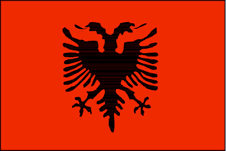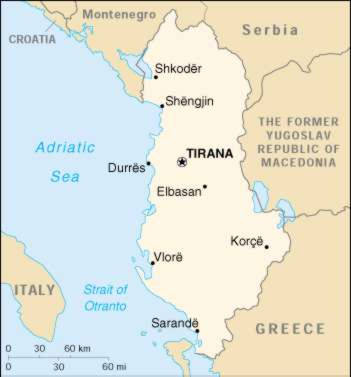Between 1990 and 1992 Albania ended 46 years of xenophobic Communist rule and established a multiparty democracy. The transition has proven difficult as corrupt governments have tried to deal with high unemployment, a dilapidated infrastructure, widespread gangsterism, and disruptive political opponents. International observers judged legislative elections in 2001 to be acceptable and a step toward democratic development, but identified serious deficiencies that should be addressed through reforms in the Albanian electoral code.
Population: 3,582,205 (July 2003 est.), growth rate 1.03% (2003 est.). Birth rate 18,2 per 1,000 population, death rate 6,48 per 1,000 population. Total fertility rate 2.22 children per woman. Infant mortality rate 37 deaths/1,000 live births. Life expectancy at birth 69 years for males, 75 years for females.
Currency: Lek (pl., leke); 1 EURO to Albanian Lek: 121,594 (April 2004)
|
|
Ethnic Groups: Albanian 90 percent, divided into two groups:
the Gegs to the north of the Shkumbin River and the Tosks to the south. Greeks
probably 8 percent, others (mostly Vlachs, Gypsies, Serbs and Bulgarians) at
least 2 percent.
Languages: Albanian (Tosk is official dialect, Geg also a much-used variant), Greek. Religion: Muslim 70%, Albanian Orthodox 20%, Roman Catholic 10%. In 1967 all mosques and churches were closed and religious observances prohibited; in December 1990, the ban on religious observance was lifted. Education: Free at all levels. Eight-grade primary and intermediate levels compulsory beginings at age six. Literacy rate raised from about 20 percent in 1945 to an estimated 75 percent in recent years. In 1990, primary school was attended by 96 percent of all school-age children, and secondary school by 70 percent. School operations were seriously disrupted by breakdown of public order in 1991. Health and Welfare: All medical services are free. Six months of maternity leave at approximately 85 percent salary; noncontributory state social insurance system for all workers, with 70-100 percent of salary during sick leave. Pension about 70 percent of average salary. Retirement age 50-60 for men, 45-55 for women. In the early 1990s, the health and welfare system was adversely affected by economic and social disintegration. |



